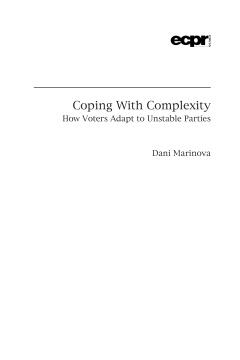
Additional Information
Book Details
Abstract
When parties undergo abrupt organisational changes between elections – such as when they fuse, split, join or abandon party lists – they alter profoundly the organisation and supply of electoral information to voters. The alternatives on the ballot are no longer fixed but need to be actively sought out instead. This book examines how voters cope with the complexity triggered by party instability. Breaking with previous literature, it suggests that voters are versatile and ingenious decision-makers. They adapt to informational complexity with a set of cognitively less costly heuristics uniquely suited to the challenges they face. A closer look at the impact of party instability on the vote advances and qualifies quintessential theories of vote choice, including proximity voting, direction-intensity appeals, economic voting and the use of cognitive heuristics. The rich and nuanced findings illustrate that political parties hold a key to understanding voter behaviour and representation in modern democracy.
Dani Marinova is Juan de la Cierva Fellow at Universitat Autònoma de Barcelona. She completed a PhD in Political Science at Indiana University in 2012. She studies how political and economic contexts condition citizens' electoral behaviour and in turn shape democratic representation. Her research has appeared in Acta Politica, Democratization, Perspectives on Politics, Political Behavior and Political Science Research and Methods.
Table of Contents
| Section Title | Page | Action | Price |
|---|---|---|---|
| Coping With Complexity | i | ||
| Table of Contents | vii | ||
| List of Figures and Tables | ix | ||
| List of Abbreviations | xi | ||
| Acknowledgements | xiii | ||
| Chapter One Coping with Complexity: Introduction to the Research Problem | 1 | ||
| Chapter Two Voting in Complex Information Environments: A Theoretical Framework | 13 | ||
| Chapter Three Electoral Instability in Parties: Concept, Measurement and Dynamics | 31 | ||
| Chapter Four Seeking Information: Voter Knowledge of Party Positions | 45 | ||
| Chapter Five Heuristics for Unstable Parties: How Voters Cope | 61 | ||
| Chapter Six Judging Competence: The Economic Vote | 83 | ||
| Chapter Seven Conclusion: A New Look at Old Theories | 103 | ||
| Appendix: Party Instability Data | 115 | ||
| Appendix to Chapter Four | 121 | ||
| Appendix to Chapter Six | 125 | ||
| Appendix: Party Names | 131 | ||
| Bibliography | 135 |
